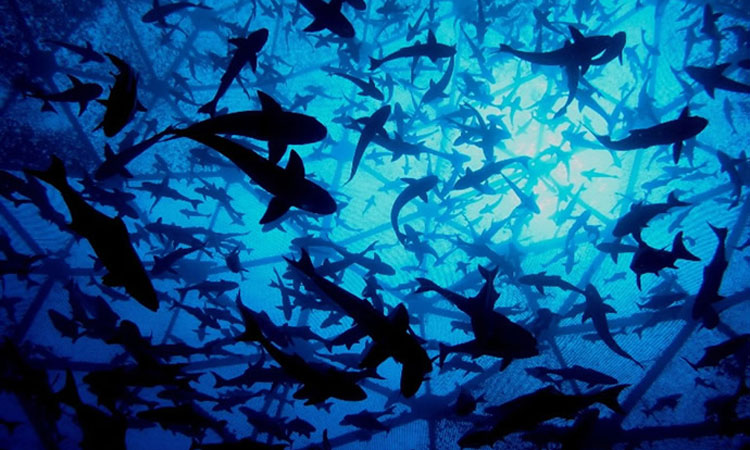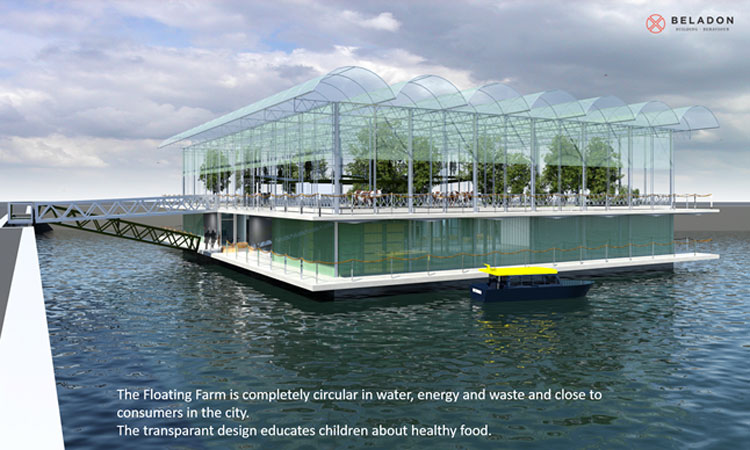As smart farming marches into the technological future, there are some weird and wonderful solutions appearing to accommodate population growth. eeDesignIt’s editor Daisy Stapley-Bunten investigates.
However an influx of offshore farming innovations is seemingly taking smart farming from cyber-space to cyber-seas. From Ocean Thermal Energy Conversion (OTEC), to off-shore wind farms and floating solar panels, renewable energy has already found its sea-legs, but now smart farming has also taken to the water.
The most obvious instance would be that of aquaculture: fish farming. The environmental impact of fish farms within enclosed waters by the shoreline is severe and spans from the risk of the escape of non-native fish, to the spread of disease to local wild fisheries. As such, the global solution to feed the growing population with fish has faced a significant ecological hurdle. InnovaSea has invented an innovative resolution, the ‘Aquapod’.

This geodesic dome will operate in open waters, far from the shoreline; this constitutes a natural growing environment for the fish, and has the added benefits of ocean currents to aid water and air circulation. The domes are constructed of individual triangle net panels fastened together in a spheroid shape, according to InnovaSea’s website, to withstand the strong currents, and is untethered and free-floating; allowing it to move with the tide. These currents prevent the problems of nutrient and effluent build-up, which are common in tethered and overcrowded nets, and work to naturally wash away the waste. The accumulation of this waste can be harmful and lead to algal blooms which deplete the water of oxygen and can be toxic to the fish. The nutrient excess can also be prevented by culturing filter-feeding shellfish, such as scallops and oysters, in-situ with the fish, as they clean their surrounding aqua environments through denitrification.
Whilst it addresses the environmental impacts of its non-technological substitutes, the ‘Aquapod’ still has a long way to go in limiting its ecological interference; from the fish feed requirements, ensuring carnivorous fish are fed from a sustainable fish source, to the pollution of chemicals that are used, such as medicines and disinfectants.
Vertical farming
A new project is making waves in the smart farming industry; Smart Floating Farms project (SFF) presented by Forward Thinking Architecture, offers a design that combines aquaculture, hydroponics, aeroponics and photovoltaics in a vertical stacking structure. The technical blueprints are explained by SFF Project Director Javier F. Ponce on the SFF website: “The top level of the SFF will integrate the green energy production facilities (photovoltaic plant combined with skylights). The resultant green power generated along with induction of natural sunlight, will be used for the second level layout of the hydroponic farm (growing crops). The waste by-products from these crops can be further used for feeding the fish on the lower level (fish farming), while the waste from the fish farms can be recycled as fertilizers for the hydroponic farm – creating a self-sufficient cycle and recycle process. The facilities will be protected in their perimeter via a series of inflatable wave protectors, thus avoiding wave risks and other climate threats.” This design creates a symbiosis of renewable energy and food production, taking waste products not just into consideration, but putting them to use.
The study by the University of Sheffield’s Grantham Centre for Sustainable Futures finds that the world has lost a third of its arable land in the past 40 years; SFF resolves this issue by taking farms to water and eliminating the need for soil with hydroculture. Hydroponics and aeroponics are both types of hydroculture, which is the process of growing plants without soil; which means less competition for arable land and less creation of infertile land. There are different methods of hydroponics, but essentially the plants are fed by systems of running water which contain nutrients for the plants to absorb as needed; aeroponics is similar, however the water is delivered in the form of a mist. Surprisingly, this water-reliant system actually uses less water than traditional agricultural methods, as the water does not get lost in the soil and is recycled. Other benefits of hydroculture include the minimized use of pesticides, as it is a controlled environment, and also the ability to grow all types of vegetables in comparison to site-specific soil, which reduces the need for imports; meaning reduced transportation costs and a reduced impact on the environment.
SFF is currently in the funding stages and is further developing studies with the support of specialists, Javier F. Ponce added, “We aim that these floating farms can be located close to areas where food is more needed, causing a positive social and economic impact, with the potential of creating new emergent economies and also some of them becoming automated Farm Clusters run by the use of IT technologies/software.”
Floating cows
Construction has started on a floating dairy farm in Rotterdam in the Netherlands by Floating Farm and is expected to be completed by December 2016; the dairy will not only produce milk and yogurt, but will also be a research lab and educational center. The aim of the project is to minimize the transportation, and the environmental problems as implicated, of dairy products to urban cities. The floating structure will encompass a range of renewable processes; the facility will be powered by solar panels and turbines, the grass grown to feed the cows will be fertilized by the cow’s own manure, rainwater will be filtered for the cows to drink, and the cow’s waste will be processed so as to distribute fertilizer around the city. This creates a self-sufficient environment close to the city. In an interview with The New Economy magazine, Peter van Wingerden, CEO and Partner at Beladon, one of the partners of the Floating Farm project, elaborated: “By producing animal fodder within the floating construction, our land usage is only a fraction of what is normally needed for this type of production. The entire production process is located on the water, meaning we reduced our claim on already scarce farmable land.”

The research lab will be a ‘living laboratory’ according to the Floating Farm website, which will be ‘transparent to visitors [and] where research companies and universities are welcome to test and experiment on sustainable, self-sufficient dairy farm production.’ The research lab will work to improve food production processes, waste and water treatment. One of the main technological features of the smart farm is the waste treatment. Van Wingerden explained how this technology will operate: “The floor has been specially designed to separate urine and manure. By separating these waste materials they can be better treated, allowing us to process them into their next stages while also overcoming the massive production of ammoniac in the stable. The dry manure is picked out by a manure robot, distilled and then partly transformed into burning blocks to create energy and heat for the processes on board, and partly into plant feed. This plant feed is then distributed around the city. We also produce plant feed for the cows in our own floating construction.”
The Floating Farm tackles the environmental footprint of dairy product distribution to urban areas, whilst also offering innovative research and a public educational facility to teach children about healthy food and food processes.


Comments are closed, but trackbacks and pingbacks are open.